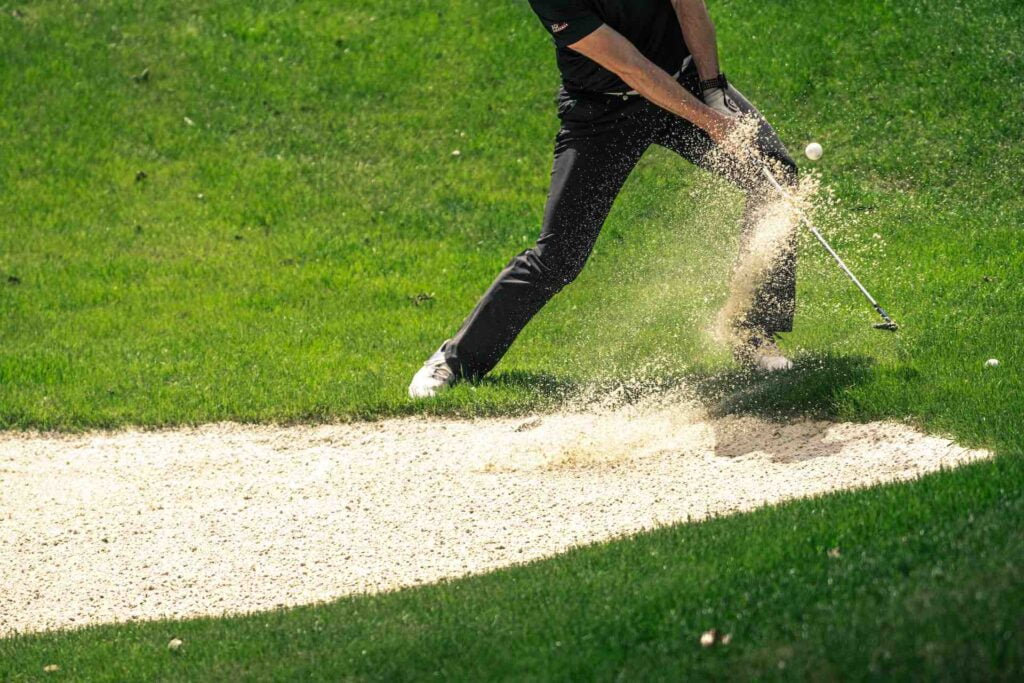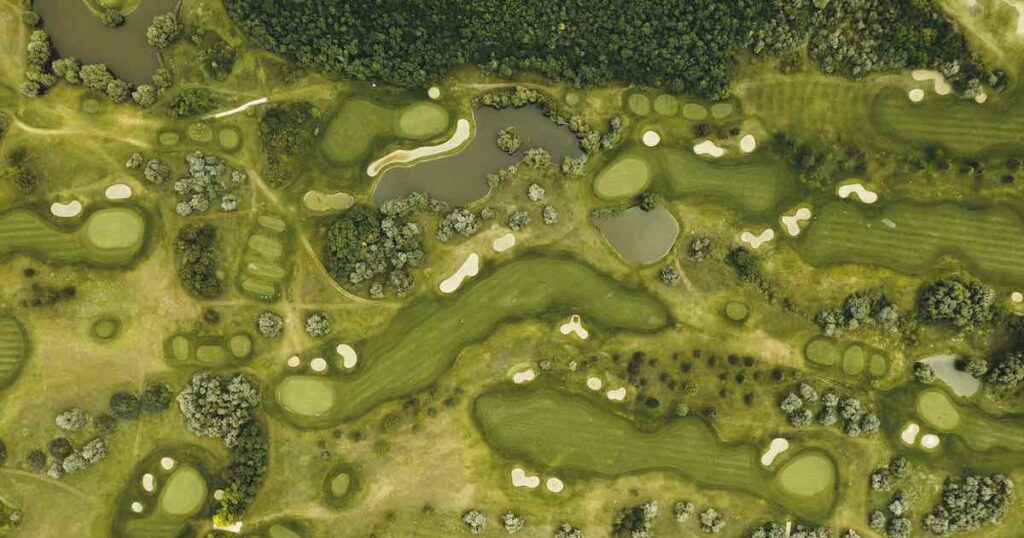Golf requires both precision and strategy, where every degree can make a significant difference. But what degree is a pitching wedge, and how does that impact how you should you use it? Understanding wedges is a crucial aspect of the game that significantly influences a golfer’s performance. Knowing when to use a specific wedge can be the critical factor between saving par or dropping a shot. In the sections below, we will cover each type of wedge, its loft, typical yardages, and the type of shots it’s best for. This knowledge will improve your understanding of the game and equip you with the skills to navigate the course more effectively.
What are Golf Wedges?

Golf wedges are specialized clubs for shorter, more accurate shots toward the green. Each wedge is designed for specific situations, allowing golfers to make precise shots in various scenarios. These clubs are categorized based on their loft, which is the angle of the clubface that controls the trajectory and distance of the golf ball.
The four main types of golf wedges that every golfer should be familiar with are the Pitching Wedge, Gap Wedge or Approach Wedge, Sand Wedge, and Lob Wedge. Each type of wedge serves a unique purpose, offers different lofts, and is used for distinct shots. Understanding their lofts, their backspin creation, and their applications can significantly improve your short game
What is a Pitching Wedge?

The Pitching Wedge, often abbreviated as PW or P on clubs, is among the most commonly used clubs in a golfer’s bag. It’s a versatile wedge that serves many purposes, making it an essential tool for golfers of every level.
What Degree is a Pitching Wedge?
The loft degree of a pitching wedge typically ranges from 43° to 47°. This range makes it the least lofted (i.e., the flattest face) among the wedges, which means it can hit the ball further than the others. The specific loft of a pitching wedge may vary depending on the manufacturer and the particular set of clubs.
Typical Yardages
The distance a golfer can achieve with a pitching wedge depends on several factors, including their swing speed, the ball they’re using, their mechanics and the cleanliness of the grooves on the club. However, on average, golfers typically hit a pitching wedge between 100 to 140 yards. Remember, these are average distances, and individual results may vary.
Types of Shots
The pitching wedge is a highly versatile club, making it suitable for various shots. It’s primarily used for full approach shots, especially when the golfer is about 100-125 yards out from the green. Additionally, it’s also commonly used for chip shots around the green when the golfer wants the ball to roll out more.
Moreover, the pitching wedge can be used for longer bunker shots where a sand wedge might not provide enough distance. It’s also handy for pitch shots, where the golfer needs the ball to fly high and land on the green softly with minimal roll.
Summary
In conclusion, the pitching wedge is a valuable and versatile tool in the golfer’s arsenal. Its lower loft allows for longer distances, while its design enables precision and control for various shots.
What is a Gap Wedge or Approach Wedge?

The Gap Wedge, also referred to as an Approach Wedge, is often marked on clubs as GW, G, AW, or A, depending on the maker. It is a pivotal piece of equipment for most golfers. As the name suggests, it’s designed to fill the ‘gap’ in loft and distance between the pitching wedge and the sand wedge.
What Degree is a Gap Wedge?
The loft of a gap wedge usually ranges from 47° to 52°. This mid-range loft makes it a perfect intermediary between a pitching wedge’s lower loft and a sand wedge’s higher loft. The specific loft of a gap wedge can also vary by manufacturer and the respective set of clubs.
Typical Yardages
A gap wedge is typically used for shots that are too long for a sand wedge but too short for a pitching wedge. On average, a golfer can expect to hit a gap wedge around 75 to 100 yards. However, this also depends on the golfer’s swing and golf ball.
Types of Shots
The gap wedge shines in its versatility. As mentioned, it is helpful for approach shots where a pitching wedge would be too much, and a sand wedge wouldn’t cover the distance.
Besides full shots, the gap wedge is also great for chip-and-run shots near the green, where you want the ball to fly a bit and then roll toward the hole. It’s also useful when you need to get over a bunker or other obstacle but still want the ball to land relatively softly and with less roll than a pitching wedge.
Summary
The gap wedge is an excellent bridge between your pitching and sand wedges. Whether approaching the green from a mid-range distance, chipping from the fringe, or negotiating a tricky bunker, the gap wedge offers a balance of loft and distance that can help you navigate these situations confidently.
What is a Sand Wedge?

The Sand Wedge is often abbreviated as SW, S, or simply the degree of the club, such as 56°. This is a specialized tool designed with one primary purpose in mind – to help golfers escape from sand traps or bunkers. However, its use isn’t limited to just sand; it’s also an excellent choice for various other shots on the course.
What degree is a Sand Wedge?
The loft of a sand wedge can range between 54° to 57°, but most often, they are 56°. Compared to pitching and gap wedges, this higher loft allows for higher trajectory shots that can clear taller obstacles and stick on the green. As always, the specific loft can vary depending on the manufacturer and the particular set of clubs.
Typical Yardages
Given its higher loft, the sand wedge doesn’t hit the ball as far as the pitching or gap wedge. On average, typical golfers will hit a sand wedge between 70 to 90 yards with a full swing. Of course, this depends on individual factors.
Types of Shots
As the name suggests, the sand wedge is the go-to club for bunker shots. It is designed with a wider sole and bounce (the angle of the front edge of the club) to help it slide through the sand rather than digging into it. This makes it easier to lift the ball out of the sand and land it on the green.
However, the sand wedge isn’t only for the bunker. It’s also perfect for short approach shots where you want the ball to fly high and land softly with minimal roll. The sand wedge is also an excellent choice for lob shots over hazards or when you’re close to the green and must get the ball up quickly.
Furthermore, a sand wedge can be used effectively for chip shots around the green when you need to stop the ball quickly without much roll.
Summary
While the sand wedge specializes in helping golfers escape the bunker, its utility extends far beyond the sand. With its high loft and unique design, it’s an invaluable club for various shots on the course, especially when precision and control are of the essence.
What is a Lob Wedge?

The Lob Wedge, often abbreviated as LW, L, or, again, the degree of the club, is the highest lofted club in a golfer’s bag. It’s a specialty club designed to provide a high trajectory and extreme precision on short-distance shots.
What Degree is a Lob Wedge?
The loft of a lob wedge is typically greater than 58°, with some ultra-high lofted wedges reaching up to 64°. However, most lob wedges have a loft of 60°. This high degree of loft allows the lob wedge to lift the ball high into the air, even over obstacles, and make it land softly on the green with minimal roll. The specific loft can vary depending on the manufacturer and the particular set of clubs.
Typical Yardages
A lob wedge is used for relatively short distances, given its high loft. On average, golfers can expect to hit a lob wedge around 40 to 60 yards. Keep in mind this can depend on the particulars of the golfer.
Types of Shots
The lob wedge is the go-to club for high-trajectory shots over obstacles. Whether you’re trying to clear a tall tree or a towering bunker lip, the lob wedge can send the ball high into the sky and then drop it softly onto the green.
In addition to these lofty shots, the lob wedge is also perfect for flop shots, where you need to get the ball high quickly and make it stop almost immediately after landing. Think of Phil Mickelson’s flop shot over Steph Curry, for example. This makes it an excellent choice when you’re close to the green but have little green to work with.
Moreover, a lob wedge is great for chipping the ball onto the green with very little roll. It’s also handy in deep rough or sand, where its high loft can help lift the ball.
Summary
The lob wedge is a specialist in high, soft-landing shots. Its high loft and precision make it an essential tool for navigating obstacles and tricky situations around the green. Whether you’re lofting the ball over a tree, executing a delicate flop shot, or chipping from the fringe, the lob wedge can be your best friend on the golf course if you know how to use it.
Choosing the Right Wedges
Now that you know the answer to “What degree is a pitching wedge?” it’s time for another question – How do you choose the right wedges for your game? Picking the optimal wedges for your golf bag can be a important decision that impacts your performance on the course. The choice should be based on a few factors, including individual playing style, course conditions, and the need for versatility.
Individual Playing Style & Course Conditions
Your playing style and the typical conditions of the courses should heavily influence your wedge selection. For instance, if you often play on courses with deep rough or tall bunkers, a lob wedge with its high loft might be a valuable addition to your bag. On the other hand, if you frequently play on courses with vast fairways and less sand, a gap wedge or sand wedge may serve you better.
Additionally, consider your strengths and weaknesses as a player. If you struggle with long irons, wedges with varying lofts can help you cover those distances more reliably. Conversely, if you’re confident with your long game but need help with precision around the greens, focusing on higher lofted wedges like the sand wedge and lob wedge could be beneficial.
Loft Gapping
Another key aspect to consider when selecting your wedges is the gap of degrees between each one. This is referred to as ‘loft gapping’ and is vital to ensuring a smooth transition from one club to another in terms of distance coverage. Aim for a consistent loft gap of about 4-6 degrees between each wedge. This ensures you have a club for every situation without significant distance gaps.
For example, if your pitching wedge is 46°, a gap wedge around 50°, a sand wedge around 54°, and a lob wedge around 58° would provide a balanced spread of lofts to cover a wide range of distances and shot types.
Final Thoughts
Wedges are among the most versatile clubs in a golfer’s bag. Understanding the different types of golf wedges, their lofts, and their uses is crucial for any golfer looking to improve on the course. Moreover, knowing the importance of loft gapping can help you ensure no significant distance gaps occur in your game.
Finally, remember the versatility that wedges offer. They’re not just for full swings but also your go-to clubs for chips, pitches, bunker shots, and more. Having a variety of lofts in your bag can significantly enhance your ability to handle various scenarios on the course. The world of golf wedges is diverse and nuanced. But with some knowledge and experimentation, you can wield these essential tools to elevate your game to new heights.
For more insights into the fundamentals of the game, be sure to visit our Golf Basics section.



